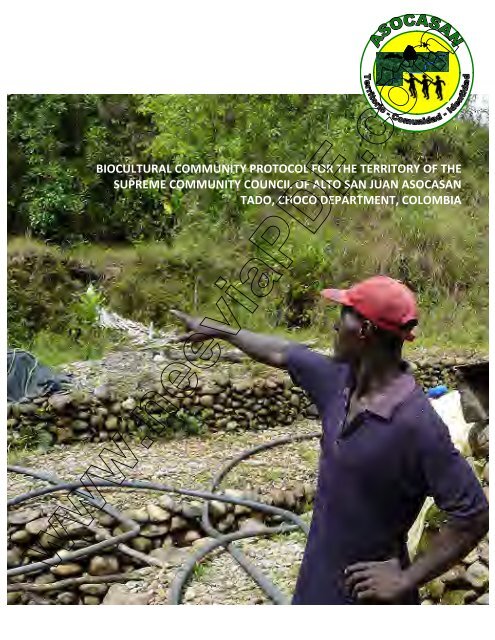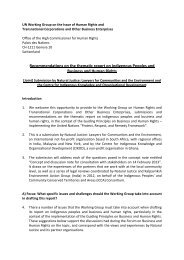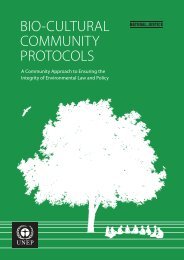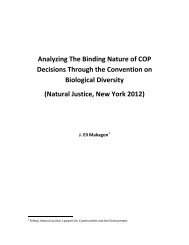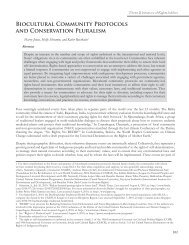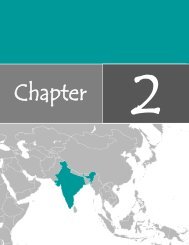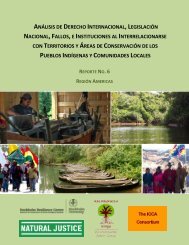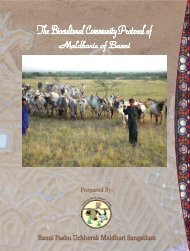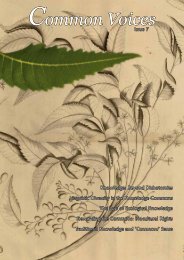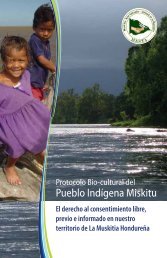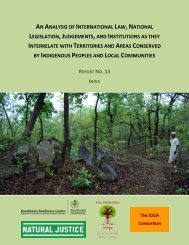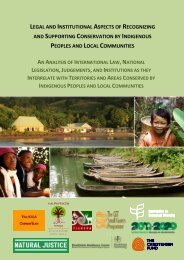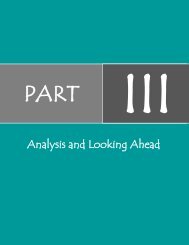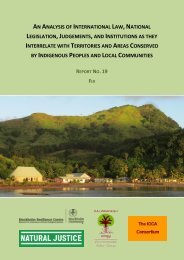Biocultural community protocol Alto San Juan - Natural Justice
Biocultural community protocol Alto San Juan - Natural Justice
Biocultural community protocol Alto San Juan - Natural Justice
Create successful ePaper yourself
Turn your PDF publications into a flip-book with our unique Google optimized e-Paper software.
SUCCURSALES EUROPEENNES D'ENTREPRISES EUROPEENNES EXERCANT EN LPS EN FRANCE AU 01/07/2013DÉNOMINATION SOCIALE ACP ADRESSE DU SIÈGE SOCIAL ADRESSE DE LA SUCCURSALEPAYS DE LASUCCURSALEPAYS D'ORIGINEBRANCHES D'ACTIVITÉCOMMENTAIRESBRANCHES D'ACTIVITÉOBSERVATIONSAXA ART VERSICHERUNG AGà partir de la succursale néerlandaiseColonia Allee 10 2051067 COLOGNEWaterstraat 1NL-4811 VB BREDAPAYS-BAS ALLEMAGNE 7 8 9 13 16AXA VERSICHERUNG AKTIENGESELLSCHAFTà partir de la succursale belgeColonia Allee 10 20Postfach 80 50 5051058 COLOGNE47-51, rue du Luxembourg1050 BRUXELLESBELGIQUE ALLEMAGNE 1 4 5 6 7 8 9 11 12 13 16AXA VERSICHERUNG AKTIENGESELLSCHAFTà partir de la succursale irlandaiseColonia Allee 10 20Postfach 80 50 5051058 COLOGNE3, Harbourmaster Place IFSCDUBLINIRLANDE ALLEMAGNE 1 4 5 6 7 8 9 11 12 13 16AXA VERSICHERUNG AKTIENGESELLSCHAFTà partir de la succursale luxembourgeoiseColonia Allee 10 20Postfach 80 50 5051058 COLOGNE17, rue Beaumont1219 LUXEMBOURGLUXEMBOURG ALLEMAGNE 1 4 5 6 7 8 9 11 12 13 16AXIS SPECIALTY EUROPE SEà partir de la succursale britanniqueMount Herbert Court34, Upper Mount StreetDUBLIN 24th FloorPlantation Place South60 Great Tower StreetLONDRES EC3R 5 AZROYAUME-UNI IRLANDE 1 2 4 5 6 7 8 9 11 12 13 14 15 16 17 18BUPA INSURANCE LIMITEDà partir de la succursale danoiseBupa House15-19 Bloomsbury WayLONDRES WC1A 2 BA8 PalaegadeCOPENHAGUEDANEMARK ROYAUME-UNI 1 2 7 8 9 13 16 17 18BUPA INSURANCE LIMITEDà partir de la succursale espagnoleBupa House15-19 Bloomsbury WayLONDRES WC1A 2 BAEdif. Tres Coronas, portal D Apt 202,Avd. C Diaz Ruiz 4,Fuengirola 29640 MALAGAESPAGNE ROYAUME-UNI 1 2CHUBB INSURANCE COMPANY OF EUROPE SEà partir de la succursale allemande106 Fenchurch StreetLONDRES EC3M 5NBCICE, Martin-Luther-Platz 2840212 DUSSELDORFALLEMAGNE ROYAUME-UNI 1 2 3 4 5 6 7 8 9 10 11 12 13 14 15 16 17 18 10 (RC transporteur uniquement)CHUBB INSURANCE COMPANY OF EUROPE SEà partir de la succursale autrichienne106 Fenchurch StreetLONDRES EC3M 5NBAUTRICHE ROYAUME-UNI 1 2 3 4 5 6 7 8 9 10 11 12 13 14 15 16 17 18 10 (RC transporteur uniquement)CHUBB INSURANCE COMPANY OF EUROPE SEà partir de la succursale danoise106 Fenchurch StreetLONDRES EC3M 5NBPFA Skade-Agentur A/SSundkrogsgade 4DK-2100 COPENHAGUEDANEMARK ROYAUME-UNI 1 2 3 4 5 6 7 8 9 10 11 12 13 14 15 16 17 18 10 (RC transporteur uniquement)Suc c urs ales européennes d' entrepris es européennes ex erç ant en LPS en Franc eSec rétariat général de l' Autorité de Contrôle Prudentiel
BIOCULTURAL COMMUNITY PROTOCOL ALTO SAN JUAN | 6 The right to collective ownership of ancestral lands 4 was granted by the State to the <strong>Alto</strong> <strong>San</strong> <strong>Juan</strong> <strong>community</strong> by means of Colombian Institute of Agrarian Reform (INCORA) Resolution 27-‐27 of 27 December 2001. National legislation recognises this as a fundamental right that cannot be restricted by governments, nor can ownership be transferred into private hands. The territory belongs to the <strong>community</strong> and it shall remain so for generations to come. 5‘Our territory is collective. This is the basis for our model of local development. It respects living spaces and family production areas, with ownership being defined according to inherited ancestral occupancy and <strong>community</strong> recognition. Collective territory is a strategy for preserving the resources and culture and a place where we, as an Afro-‐descendent <strong>community</strong>, can promote <strong>community</strong> production practices like small-‐scale mining, nursery gardening and mixed cropping systems to maintain a high level of diversity in our territory.’ – Wilson Mosquera, former President of the ASOCASAN Board of Directors The soils and forests included in the territory retain a high level of biological diversity due, in large part, to our traditional management practices, that have created a productive and natural mosaic reflecting the use of areas according to ancestral knowledge and the configuration of natural resources. The way our territory is regulated (Appendix 5, paragraph 7) reflects our relationship with its natural resources. It is the product of local knowledge, which regulates land occupancy in line with resource use, taking into account traditional production systems and the natural structure and condition of the areas. Therefore, it is critical to include, through effective participation, our regulatory processes and traditional use and conservation practices in municipal territorial development planning processes. 64 ILO Convention 169 states that ‘The rights of ownership and possession of the peoples concerned over the lands which they traditionally occupy shall be recognised.’ 5 Article 7 of Law 70 of Colombia (1993): In Recognition of the Right of Black Colombians to Collectively Own and Occupy their Ancestral Lands, concerning recognition of collective rights states that the area of land designated for collective use is inalienable, imprescriptible and immune from seizure. www.neeviaPDF.com6 Colombian Territorial Planning Law 388 (1997) observes that it is important to ‘reconcile social and economic interests.’ This is achieved through the democratic participation of all inhabitants and organisations that exist
BIOCULTURAL COMMUNITY PROTOCOL ALTO SAN JUAN | 7 Collective ownership provides a framework to protect and conserve the integrity of a <strong>community</strong>’s natural and cultural components. CULTURE AND COMMUNITY The arrival of Afro-‐Colombian communities and the settlement of the <strong>Alto</strong> <strong>San</strong> <strong>Juan</strong> region dates back to 1530 and the establishment of the mining district of Monte Carmelo. With its rich seams of gold and platinum, mining defined the cultural conditions of the area and the region quickly developed through several trade routes with Carmelo, Andágueda, <strong>San</strong> Pablo and <strong>San</strong> <strong>Juan</strong>. The history of the mining economy is steeped in the exploitation of <strong>Alto</strong> <strong>San</strong> <strong>Juan</strong>’s Afro-‐Colombian communities. However, the industry gave rise to a culture which was the product of adaptation to environmental conditions, underpinned by principles of inter-‐ethnic relations, forms of land occupancy and work, and knowledge about the territory’s natural resources that have been passed down through generations. The construction in 1910 of the ‘Camino Nacional’ highway to Chocó shaped the <strong>community</strong> by placing it at the crossroads of two different concepts about the world and development: the so-called Coffee Belt which supplied leading Creole families with gold and focused purely on economic interests and the Pacific Basin with its great natural diversity that represented an ‘We have maintained our <strong>community</strong>’s opportunity for freedom to our Afro-‐ wellbeing, shaping our territory according to descendent ancestors. This engendered close the sensible use inherent in our cultural links with the area’s natural resources, that practices, which helps preserve the integrity of developed into mutual adaptation of the culture and the landscape. Generations of our territory’s natural resources.’ resistance by black communities through social movements and their adaptation to the Representative of the Board of Directors of territory created an indestructible link that has ASOCASAN remained to this day. 7 How the <strong>Alto</strong> <strong>San</strong> <strong>Juan</strong> <strong>community</strong> defines itself 8We, the <strong>Alto</strong> <strong>San</strong> <strong>Juan</strong> <strong>community</strong>, define ourselves as a group of Afro-‐Colombian families, neighbours and friends who share traditions (gastronomic, medicinal, musical), beliefs (spiritual, religious) and customs (in relationships, resource management and ways of working). These are in these localities. Furthermore, conditions of local cultural and ethnic diversity must be addressed by ‘recognising pluralism and respecting difference,’ in order to achieve the optimum use of natural and human resources to improve the quality of life and general wellbeing of the region’s inhabitants. 7 Mosquera, C. H. (2003), ‘Conozca ASOCASAN’ (Find out about ASOCASAN). Unpublished document. Playa de www.neeviaPDF.comOro, Chocó Department, Colombia. 8 Relates to the definition of <strong>community</strong> set out in Article 2 on Black Communities in Law 70 (1993).
BIOCULTURAL COMMUNITY PROTOCOL ALTO SAN JUAN | 9 This document is a way of affirming our fundamental aims as expressed in property rights, customary laws and <strong>community</strong> development concepts, as well as our interest in recognising our differences with external actors, through a participatory process that allows the <strong>community</strong> to make decisions about their own development, while respecting principles of human dignity and pluralism. This requires starting out with a rights-‐based focus, particularly regarding self-‐determination, recognition of our relationship with biodiversity and our territorial and cultural rights under national and international law. OUR RELATIONSHIP WITH NATURAL RESOURCES Our relationship with nature corresponds to a historical-‐cultural process of obtaining knowledge about our territory’s natural resources. 11 Our ancestral practices contribute to the preservation of natural resources and make <strong>community</strong> self-‐development possible. The traditional spatial pattern of land occupation and use works vertically up from the floor of the basin, that is to say, from the flood plain to the mountain ridges, a pattern traditionally maintained by the settlement landlord. The traditional system of <strong>community</strong> production is a multi-‐option system based on a combination of farming, fishing, mining, forestry, animal husbandry, hunting and crafts. These territorial use practices are grounded in traditional knowledge in line with what nature offers and the conditions of the landscape. and the lands they occupy or otherwise use, and to exercise control, to the extent possible, over their own economic, social and cultural development.’ 11 According to the Inter-‐American Court of Human Rights, rights over resources are a necessary consequence of the right to territorial ownership. This is based on the fact that ‘members of tribal and indigenous communities have the right to own the natural resources they have traditionally used within their territory for the same reasons that they have a right to own the land they have traditionally used and occupied for centuries.’ Inter-‐American Commission on Human Rights. OEA/SER.L/V/II.Doc 56/09, 30 December 2009, paragraphs 181 and 182. www.neeviaPDF.com
BIOCULTURAL COMMUNITY PROTOCOL ALTO SAN JUAN | 10 Our production methods and systems Traditional practices are passed down through generations and involve zoning and distinctive forms of use. They are consistent with <strong>community</strong> principles and the ecological aspects of our territory’s natural resources that have been maintained for generations. Production activities around the river basin are spatially distributed in accordance with traditional knowledge and the condition of the landscape: forestry and hunting on the high ground (the <strong>community</strong> forests 12 ); agriculture (mixed cropping systems), mining and wood-‐cutting for domestic use in the middle zone (family units); and fishing and other productive activities on the low ground (Appendix 3). The family is the basis for production systems. The division of labour is differentiated for women, minors and men, and there are principles for the exchange of services between different families in the <strong>community</strong>. OUR RELATIONSHIP WITH MINERAL RESOURCES Gold and platinum mining is a traditional, ancestral practice of great importance for the <strong>community</strong>, given that up to 80% of the population works in small-‐scale mining. This mining is for the most part environmentally sustainable, contributes to family finances and maintains associative forms of work in the <strong>community</strong>. Traditional mining Traditional mining is recognised in Article 2 of Law 70 (1993) as a traditional practice. As such its work mechanisms are seen as part of our cultural identity. It is now a practice internalised within the region’s collectivity and is rich in techniques and knowledge about the art of mining and the natural environment. It is carried out without the use of contaminants and includes methods for reclaiming mined areas through planting a wide variety of crops, contributing food security. This practice is currently certified in the region by the ‘Green Gold’ programme, a voluntary system which focuses on ten sustainability criteria (Appendix 4). The initiative supports, fosters and promotes sustainable small-‐scale mining in the territory which, in 2010, achieved the highest standard for fair trade and fair mining in small-‐scale mining. www.neeviaPDF.com12 Community forests are areas of communal use located within the collective land titled to the <strong>community</strong> and are for collective use and exploitation.
BIOCULTURAL COMMUNITY PROTOCOL ALTO SAN JUAN | 11 Traditional mining is carried out in secondary forest areas and extracts superficial ore (approximately 15 metres below ground level) without permanently affecting the natural dynamic of the river or the daily activities of inhabitants in the river basin. ‘We use natural materials to ‘cut the gold’ (the process to extract the gold from the Jagua granite). We use balsa wood, a forest species which is non-‐polluting and non-‐toxic for aquatic life.’ – Luis Fermín, small-‐scale miner By using this plant there is no need to use mercury or cyanide. This know-‐how, which has been passed down through generations, requires knowledge of the use and maintenance of this particular species. Waste material resulting from gold mining activities is deposited along the riverbed, creating rock terraces. These are topped with organic waste to encourage revegetation and, in the medium term, are used for complementary agricultural activities. Given that a small-‐scale mine is often worked over 15 years or even over generations, this system minimises the fragmentation of habitats and degradation processes in areas given over to mining. Today technological elements are being included to improve work efficiency in line with the <strong>community</strong>’s principles for sustainable practice. Terraces of gold mine waste prior to revegetation. www.neeviaPDF.com
OUR USE OF THE FOREST BIOCULTURAL COMMUNITY PROTOCOL ALTO SAN JUAN | 13 Densely wooded areas are recognised as <strong>community</strong> conservation areas where the forest is exploited for domestic purposes. In <strong>Alto</strong> <strong>San</strong> <strong>Juan</strong>, people commonly use forest timber to build their homes and craft canoes, stakes, paddles, punts, mining pans and a variety of home utensils, as permitted by the ministry in Article 19 of Law 70 (1993), according to criteria related to traditional practices using tools and cutting methods that permit the forests to regenerate (Appendix 4). Logging activity depends on the external timber market, which determines the profitability of this extractive activity. Although logging has experienced some periods of intense activity, good forest cover has been maintained through internal agreements on access to forest resources. Timber and non-‐timber forest exploitation The forest or mountain is understood by the <strong>community</strong> in two different ways: Monte Bravo/Biche and Monte Jecho. Monte Bravo refers to zones of low intervention, dense mixed forest that serve as a <strong>community</strong> resource for collective use, public amenity and social interest. These zones are also culturally important for traditional healers who know that the plants used for magic-‐religious purposes are found in well-‐preserved areas of forest. As such, and in the context of <strong>community</strong> autonomy, we consider that commercial forestry must take into account property rights over natural resources (Appendix 6, paragraph 5), comply with legal permits for these types of extractions and obtain prior authorisation from the <strong>community</strong> council. The <strong>community</strong> council has the authority to manage its own forest resources − a process that must be recognised in the regulations, which according to the law must be developed in concert with the environmental authorities. This is a precondition for undertaking any type of exploitation. 14Community forests contain important areas that must be preserved to ensure the autonomy of the <strong>community</strong>. The <strong>community</strong> itself identifies these areas, which are used specifically for low intensity production that adheres to traditional criteria and is in line with internal and inter-‐ethnic use 14 The Constitutional Court has stated that only communities are authorised and empowered to use forest resources in their territory without any limitation on their right to involve third parties. Benefits must remain within the communities, and there can be no commercial exploitation until resource regulations guaranteeing sustainable and culturally sensitive use have been drawn up or are in place. See Judgement T-‐955 of 2003. www.neeviaPDF.com
BIOCULTURAL COMMUNITY PROTOCOL ALTO SAN JUAN | 15 All this suggests a wealth of common knowledge about plant species and their uses, prompting third party scientific research and development in this area. Such research must, however, be carried out in consultation with communities and take into account the guidelines for access, compensation and equitable sharing of any benefits arising (Appendix 7, paragraph 1). CHALLENGES FOR THE TERRITORY With all the above in mind and taking into account the link between <strong>community</strong>, knowledge and natural resources, it is necessary to regulate access to our territory in order to: maintain the traditional systems of knowledge that form our identity; manage the factors for physical and cultural cohesion that ensure our survival as a <strong>community</strong> (Appendix 5, paragraph 1); and uphold our aspirations regarding future development. We want development to consider our vision, principles and methods of <strong>community</strong> organisation (Appendix 5, paragraph 7), including our traditional practices of natural resource use and management in the territory. The <strong>Alto</strong> <strong>San</strong> <strong>Juan</strong> area is open to the threat of partial or full displacement of its inhabitants, which has been mainly caused in recent years by the generalised violence that accompanies economic interest in the territory’s natural resources. Practices that focus on economic growth degrade our territory’s natural resources, autonomy and <strong>community</strong> government, and also harm our traditional forms of organisation and systems of production. The environmental challenges are related to the total failure of the responsible government bodies to control economic pressures on our natural resources. There needs to be sustained coordination between <strong>community</strong> interests and roles and the responsible agencies in order to monitor and control natural resources. To reaffirm our customary rights, it is necessary to be familiar with national legislation related to natural resources, culture and territory, such as mining legislation, land law, forest law, the draft law on royalties and international developments which are applicable to our rights and which contribute to resolving the challenges expressed herein. www.neeviaPDF.com
BIOCULTURAL COMMUNITY PROTOCOL ALTO SAN JUAN | 16 Illicit mechanised mining 15Illicit mining is conducted primarily by people from outside the <strong>community</strong> using heavy machinery (hydraulic excavators) and is increasing substantially in the territory. It is changing our traditional way of life, introducing external values that lead to a progressive loss of our traditional knowledge and practices associated with managing natural resources and environmental balance. Even though regulations require environmental permits (Appendix 7, paragraph 3) from the exploitation phase onward, the environmental authorities are not able to carry out their duties to evaluate, monitor and control actions which harm the territory’s natural resources. 16 Effective, consistent legal regulation is required from the various authorities responsible to monitor and control natural resources (Mayor’s office, the Autonomous Regional Corporation for the Sustainable Development of Chocó [CODECHOCO] and the Colombian Institute of Geology and Mining [INGEOMINAS]) during every stage of extraction and also commercialisation of gold illegally mined in the territory. This type of extraction, even though it is both an administrative infraction and a criminal offence, goes uninvestigated and unpunished, and its environmental impacts are neither measured nor compensated. Consultation is not the only requirement for mining in collective territories (Appendix 8, paragraph 2): free, prior and informed consent of affected communities is also essential. 15 By illicit mining we mean that which is undertaken without permits or permission and, as such, is not registered with the National Mining Register and operates outside the law (for example, failing to register with the mayor’s office, or to gain environmental permits and permission from the <strong>community</strong>). 16 The Constitutional Court has indicated that an environmental impact assessment is a precondition for any mining work (no matter what stage or phase of development the project is at) and has also clarified that prior consultation must be undertaken for the environmental licence, for any decision liable to affect communities (as mining concessions, by nature, do), and even as a requirement for prospecting activities. See Judgement C-‐ 339 of 2002. www.neeviaPDF.com
BIOCULTURAL COMMUNITY PROTOCOL ALTO SAN JUAN | 17 High impact mechanised mining “When we allow in the hydraulic excavators (illegal mechanised mining), the gold is gone in a year. What’s left is useless land and the remaining money must be shared out between all family members. In the end, the money, like the land and our children’s inheritance, is gone. What we are left with is problems: polluted watercourses, holes in the earth and lagoons of contaminated water. So the remaining land cannot be worked, either for mining or agriculture, and we are left without way to generate income. We are then obliged to change how we work and must search for gold behind a machine. This does not permit associative forms of work; each person must always look after him or herself. When the machine operator allows a person to descend into the pit to work at high risk alongside the machine, each person has to look after his or her own safety, without any thought about whoever is working at their side. Small-‐scale miners do not live this kind of life. -‐ Belamina, small-‐scale miner Illegal logging The <strong>Alto</strong> <strong>San</strong> <strong>Juan</strong> <strong>community</strong> forest areas are threatened by illegal logging driven by external demand. This type of extraction, which ignores the dynamics of nature and of timber and non-‐timber resource management, is a major cause of deforestation. Forest-‐dwelling populations are diminished as loggers fail to consider the technical and <strong>community</strong> management criteria, which impacts on natural resources, local autonomy and ethno-‐territorial governance. www.neeviaPDF.comAll types of commercial logging that fail to comply with our principles or gain authorisation or are unregulated undermine ethnic rights to manage and control the territory and our forms of resource use.
BIOCULTURAL COMMUNITY PROTOCOL ALTO SAN JUAN | 18 Logging in <strong>community</strong> forest areas must be regulated by our government structure. As set out in Article 6 of Law 70 of Colombia (1993), the National Congress endorsed the understanding that forests and soils form part of the collective property of black communities. As such, regular forest use must be regulated by local communities (Article 24, Law 70) who can undertake forest extraction directly and exclusively or through partnership, on equal terms, with public or private bodies. However, a necessary condition for any such use is close cooperation and consultation between the environmental authorities and the <strong>community</strong> to define resource regulations. Illegitimate use of traditional medical knowledge Access to and appropriation of traditional knowledge by third party research into traditional medicine threatens our culture and leads to a loss of knowledge. Communities do not know the nature of research outcomes or how <strong>community</strong> knowledge may be contributing to developing potential uses for the forest’s flora and fauna (Appendix 7, paragraph 1.2). Another challenge in this area is that young people are no longer interested in learning such an exacting tradition. The sacred traditional healers, finding no suitable candidates in younger generations, are no longer passing on their lore. This has led to a crisis in traditional medicine as imposters posing as healers for personal gain step into the breach, which harms the reputation of this occupation and results in the loss of knowledge associated with traditional medicine. The loss of forests through illegal mining and logging and the lack of interest of young people to learn an exacting tradition and of the healers to teach mean that the knowledge and practices of traditional medicine are being progressively lost. The issue is further compounded by the loss of species of flora and fauna with medicinal potential. Failure to comply with participation mechanisms Lack of participation in administrative decision-‐making processes regarding development and exploitation proposals for the territory’s natural resources causes conflicts and adverse impacts. These could be reduced by properly collectivising projects and implementing suitable prior consultation processes 17 to identify and assess the impacts and alternatives for control, management, mitigation and compensation in an effective, integrated and participatory way. Currently there are few guarantees that the government will ensure participation and compliance with: 1) the right to free, prior and informed consent in relation to natural resource extraction in the collective territory, 2) the right to be informed and consulted during formulation of national policy which significantly impacts on our territories and way of life. Community participation must be guaranteed in the different phases and stages of planning and decision making related to development projects or measures which affect the <strong>community</strong> (Appendix 8, paragraph 1), as well as during implementation and monitoring of said projects and measures. 17 The <strong>community</strong> has a right to consultation. The Colombian Constitutional Court has confirmed that prior consultation is a ‘fundamental right’ in relation to projects involving the exploitation of renewable and non-renewable natural resources in collective territories. See Judgement C-‐620 of 2003. www.neeviaPDF.com
BIOCULTURAL COMMUNITY PROTOCOL ALTO SAN JUAN | 19 Local knowledge must be factored into project evaluations and, when the go ahead is given, projects must respect <strong>community</strong> needs to the greatest possible extent. 18We want the activities taking place in our territory to be based on: collective property rights (Appendix 5, paragraph 3); the right to control the territory’s existing natural resources; the concept that collective lands are inalienable, imprescriptible and immune from seizure; and the <strong>community</strong>’s right to free, prior and informed consent (Appendix 5). OUR EXPECTATIONS FOR THE FUTURE We want extractive activities in the territory to operate in ways that are technically, environmentally, economically and culturally sustainable and appropriate. We, therefore, call on the State to recognise, protect and promote small-‐scale mining as a culturally and environmentally viable production method. We want guaranteed, genuinely participative and appropriate participation processes. Therefore, the Board of Directors of the Supreme Council must be consulted regarding all proposals, actions, intervention activities and legislation that affect our territorial integrity, to ensure that the conditions to guarantee <strong>community</strong> participation are met. This means defining the process, terms, territorial scope and locations for consultation meetings so communities are able to set decision-‐making criteria in relation to proposed initiatives. www.neeviaPDF.com18 Article 44 and 49 of Law 70 (1993), and Article 7, paragraph 3 and Article 33, paragraph 2, line (a) of Law 21 (1991).
BIOCULTURAL COMMUNITY PROTOCOL ALTO SAN JUAN | 20 The following points detail our requirements for all processes, projects, programmes and activities taking place in our territory: • This document must be adopted as a fundamental tool to provide knowledge and understanding and to support negotiations with national, departmental and municipal authorities and social, political and economic actors, without prejudice to the other tools, regulations, <strong>protocol</strong>s and guidelines of the communities that require consideration or compliance. • Sufficient controls must be put in place for activities which threaten ethno-‐territorial rights, such as the current problems with illegal natural resource extraction and processing. • The State must act effectively and with cultural sensitivity to control and manage violence and conflict. • Our right to prior consultation (Appendix 8) and free, prior and informed consent must be respected and should conform to the individual requirements of the measure, project or initiative and the impacts these have on our physical, cultural and territorial integrity. The authorities representing the communities and the established procedures must be respected at all times. • Consideration must be given to how the <strong>community</strong> shares in the benefits resulting from the research and use of the territory’s natural resources and the associated knowledge, in accordance with <strong>community</strong> council guidelines. • The right of pre-‐emption 19 (Appendix 6, paragraph 1) must be adjusted to <strong>community</strong> council administration and management approaches, 20 as well as to the realities of rights on the ground. • It is important to define the levels of responsibility and the linkages among institutional actors in the territory, between the communities and the municipal authority, the regional and national environmental authorities and the United Nations High Commissioner for Refugees (UNHCR). • Activities affecting our territory will be governed by our ancestral values and standards and will respect our internal instruments for territorial management, such as the internal regulations for territorial administration and management, the regulations for the use and management of natural resources and the <strong>Biocultural</strong> Community Protocols, which contribute to the <strong>community</strong> governance strategy. 19 The Mining Code states that communities have the right of pre-‐emption in relation to third-‐party applications for mining concessions to exploit seams and mineral deposits located in black <strong>community</strong> mining areas. 20 The Constitutional Court has indicated that ‘the State must undertake corresponding positive actions including economic action,’ (such as ‘development loans, technical assistance and administrative and marketing training,’ etc.), ’to ensure the viability of mining for local groups’ or ethnic communities. See Judgement C-‐ 892 of 2002. www.neeviaPDF.com
BIOCULTURAL COMMUNITY PROTOCOL ALTO SAN JUAN | 21 • Our representative authorities and institutions and residents of the region must be guaranteed genuine opportunities to participate in projects being carried out in the territory and in all their stages of design, evaluation, implementation, monitoring and control. • State institutions must respect, protect and promote traditional practices, including those associated with small-‐scale mining operations, forest management and traditional medicine, which contribute to the sustainable management of resources and ensure the survival of the communities in the territory. • The <strong>community</strong> must be able to veto a project that negatively and significantly affects the territory and its people, as laid down by the Inter-‐American Court of Human Rights and other international authorities (Appendix 8, paragraph 2) Free, prior and informed consent We want social and environmental development that guarantees our right to free, prior and informed consent for activities affecting our territory. 21 There is already international consensus on a whole series of issues for which the free, prior and informed consent of the communities must be obtained. This means that the <strong>community</strong> has the power to make decisions and veto projects to develop, use and exploit mineral, forest or water resources where such activities may impact significantly on the rights of use and enjoyment of ancestral lands. We know that the outcomes of consultation exercises vary according to the extent of the potential consequences of the activity in question. However, there are issues and cases where, due to very high levels of potential impact on the <strong>community</strong>, the State is obliged to make a ruling or express a position. 22 In any case, mechanisms must be put in place to mitigate, counter or make reparations for any negative outcomes for the <strong>community</strong> or its members that may result from an authority’s interventions. See T 652 of 1998. Working with the authorities As a <strong>community</strong> accorded Constitutional rights and legal safeguards for the development and protection of our culture, we require the following from our work with local and national authorities: • THE MUNCIPAL LEVEL MAYOR’S OFFICE: The municipality must recognise, adopt and validate the <strong>community</strong>’s way of governing itself and its aspirations for development in municipal planning and development processes. Municipal authorities must coordinate with <strong>community</strong> authorities and provide appropriate support where necessary to control illicit activities within the territory. 21 Article 76 of Law 99 (1993) stipulates that ‘The exploitation of natural resources must be carried out without detriment to the cultural, social and economic integrity of indigenous and traditional black communities in accordance with Law 70 of 1993 and Article 330 of the National Constitution, and decisions to this regard will be taken with prior consultation of said communities.’ 22 The Constitutional Court has indicated that ‘the authority’s decision must not in any way be arbitrary or authoritarian; it must be objective and reasonable and in line with the constitutional requirements for the State to protect the social, cultural and economic identity of the <strong>community</strong>.’ Judgement T-‐652 of 1998. www.neeviaPDF.com
BIOCULTURAL COMMUNITY PROTOCOL ALTO SAN JUAN | 22 ENVIRONMENTAL AUTHORITY: The environmental authority must work with the Supreme Community Council to review applications for projects, works and activities in the <strong>Alto</strong> <strong>San</strong> <strong>Juan</strong> collective territory, including mining, forestry and other natural resource exploration and exploitation. They must also expedite the required monitoring and control of legal and illegal activities. • THE NATIONAL LEVEL THE MINISTRY OF MINES (COLOMBIAN INSTITUTE OF GEOLOGY AND MINES – INGEOMINAS 23 ): • The Ministry of Mines must consult with the Supreme Community Council ASOCASAN on the mechanisms to deliver a legitimate consultation process and to secure prior and informed consent for third-‐party mining concession applications. It must also guarantee <strong>community</strong> participation in the design of investment projects financed by royalties from mining activities in the territory. • The conditions for pre-‐emption with respect to the exploitation of mining resources must take into consideration the capacities of <strong>community</strong> councils and be adjusted accordingly, so that they differ from the stringent requirements that multinational companies must meet. THE MINISTRY OF THE ENVIRONMENT, HOUSING AND TERRITORIAL DEVELOPMENT: • The Ministry must monitor how well the Autonomous Regional Corporation for the Sustainable Development of Chocó (CODECHOCO) is carrying out its legal duties, particularly in relation to the control and penalisation of illicit activities. It must also ensure measures are put in place to reclaim land that has been degraded by the illegal extraction of renewable and non-‐renewable resources. • The cultural strategies that have helped preserve the territory and internal <strong>community</strong> agreements must be recognised, protected and promoted as effective measures for managing biodiversity, and they must be included in the guidelines for conducting environmental impact studies. • Mining exclusion zones must be set up in concert with the <strong>community</strong> and ASOCASAN in specific areas with a social and ecological function. These exclusion zones must be zoned in line with <strong>community</strong> uses and cultural practices. THE MINISTRY OF THE INTERIOR: • The Ministry must guarantee that the authorities or bodies relevant to the measure in question respect the process of prior consultation with the Supreme Council and local councils. This should include an ongoing process of support and capacity development for our <strong>community</strong> leaders to enable them to master this important tool and to assert the fundamental right of ethnic communities to prior consultation. • The Ministry must supervise processes to ensure that there is adequate consultation of affected communities in the presence of persons authorised to sign agreements. www.neeviaPDF.com23 The Ministry of Mines has delegated several of its functions to the Colombian Institute of Geology and Mines (INGEOMINAS) and six departmental governments (Antioquia, Bolívar, Boyacá, Caldas, Cesar and Norte de <strong>San</strong>tander) – see Resolution No. 180074 of 2004.
BIOCULTURAL COMMUNITY PROTOCOL ALTO SAN JUAN | 23 • The decisions taken in <strong>community</strong> consultation exercises must be taken into account when deciding to reject or request modifications to any project which threatens the <strong>community</strong>’s physical and cultural survival. • Where the right to prior consultation is violated, either through insufficient consultation or no consultation, the Ministry must be actively involved in the reparations process for any impacts engendered. Community commitments The <strong>Alto</strong> <strong>San</strong> <strong>Juan</strong> <strong>community</strong> is conscious of its rights but also of its obligations, and we commit to disseminate and apply the provisions of this Protocol. We commit to: Sustainable development based on cultural practices that promote the preservation of resources and the associated knowledge; Openly establishing relationships with external actors to implement development activities in the territory within the framework of environmental and cultural sustainability established by the <strong>community</strong>; Seeking to create coordinated mechanisms and tools that enable us to comply with and monitor the sustainability principles agreed by the <strong>community</strong> and other actors involved in the territory and thereby ensure <strong>community</strong> governance over the management of natural resources; Stand up for our territory and future generations by defending and safeguarding the non-‐negotiable principle of sustainable forestry and water use in any activities affecting the territory. www.neeviaPDF.com
BIOCULTURAL COMMUNITY PROTOCOL ALTO SAN JUAN | 24 APPENDICES APPENDIX 1: Location of the collective territory of <strong>Alto</strong> <strong>San</strong> <strong>Juan</strong>. Chocó Department COLOMBIACollective territory, Supreme Community Council of <strong>Alto</strong> <strong>San</strong> <strong>Juan</strong> ASOCASAN www.neeviaPDF.com
BIOCULTURAL COMMUNITY PROTOCOL ALTO SAN JUAN | 25 APPENDIX 2: Internal structure of the Supreme Community Council of <strong>Alto</strong> <strong>San</strong> <strong>Juan</strong> ASOCASAN ETHNO-SOCIAL AREASOCIALPROGRAMMESCHILDREN’SLANDPROGRAMME(TINI)Hierarchy: Relationship: Fiscal control: Institutional relationship: ORGANISATIONAL CHART LEGALREPRESENTATIVEALTO SAN JUANENVIRONMENTALSTATIONSOCIALGROUPSGENERAL ASSEMBLYLOCAL COUNCILS MANUNGARACOMMUNITYFARM PROJECTBOARD OFDIRECTORSPRODUCTIONPROGRAMMESGREEN GOLDLIVESTOCKFARMINGCENTRES FiscalAuditorTECHNICALAREAPRODUCERGROUPSGRUPMASANwww.neeviaPDF.com


